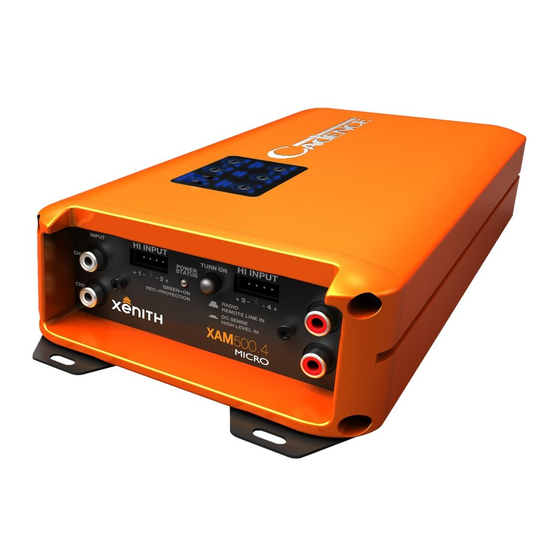
Table of Contents
Advertisement
Advertisement
Table of Contents

Subscribe to Our Youtube Channel
Summary of Contents for Cadence Xenith
-
Page 2: Table Of Contents
Page 12 Thank you for purchasing this Cadence XAM Series amplifie r. Over the years, the technology used to create audio amplifiers has grown by leaps and bounds. We have tens of thousands of satisfied customers still using our first generation Ultra Drive amplifiers which are more than 16 years old. -
Page 3: Xam600.1 Amplifier Feature Descriptions
XAM600.1 1.Line Input RCA Jacks: These inputs are for signal cables from the source. 2.High Level Input: If your head unit does not have RCA outputs, use the speaker outputs for the audio source. 3.Remote Bass Control: Remote controls the subwoofer level. 4.Smart Turn On: Turn on by headunit remote or high level input auto start. -
Page 4: Xam400.2 Amplifier Feature Descriptions
XAM400.2 1.Line Input RCA Jacks: These inputs are for signal cables from the source. 2.High Level Input: If your head unit does not have RCA outputs, use the speaker outputs for the audio source. 3.Smart Turn On: Turn on by headunit remote or high level input auto start. -
Page 5: Xam500.4 Amplifier Feature Descriptions
XAM500.4 1.Line Input RCA Jacks: These inputs are for signal cables from the source. 2.High Level Input: If your head unit does not have RCA outputs, use the speaker outputs for the audio source. 3.Smart Turn On: Turn on by headunit remote or high level input auto start. -
Page 6: Xam500.4Bt Amplifier Feature Descriptions
XAM500.4BT 1.Line Input RCA Jacks: These inputs are for signal cables from the source. 2.High Level Input: If your head unit does not have RCA outputs, use the speaker outputs for the audio source. 3.Output RCA Jacks: To audio Inputs of satellite amplifier(if present). 4.Smart Turn On: Turn on by headunit remote or high level input auto start. -
Page 7: Xam600.1 Mono Block Amplifier Applications
XAM600.1 MONO BLOCK AMPLIFIER APPLICATIONS 2-OHM MINIMUM 4-OHM EACH MINIMUM DUAL SUBWOOFERS... -
Page 8: Xam400.2 2 Channel Amplifier Applications
XAM400.2 2 CHANNEL AMPLIFIER APPLICATIONS HI PASS FILTER LOW PASS 4-OHM MINIMUM MONO SUBWOOFER HI PASS FILTER LOW PASS 2-OHM MINIMUM FULL RANGE SPEAKERS... -
Page 9: Xam500.4 4 Channel Amplifier Applications
XAM500.4 4 CHANNEL AMPLIFIER APPLICATIONS HI PASS FILTER 4-OHM EACH MINIMUM MONO SUBWOOFERS HI PASS FILTER 2-OHM EACH MINIMUM FULL RANGE SPEAKERS... -
Page 10: Xam500.4Bt 4 Channel Amplifier Applications
XAM500.4BT 4 CHANNEL AMPLIFIER WITH BLUETOOTH APPLICATIONS HI PASS FILTER 4-OHM EACH MINIMUM MONO SUBWOOFERS BLUETOOTH HI PASS FILTER 2-OHM EACH MINIMUM FULL RANGE SEAKER BLUETOOTH... -
Page 11: Xam Series Amplifier Features
XAM SERIES AMIPLIFIER FEATURES XAM400.2 MODEL XAM600.1 XAM500.4 XAM500.4BT Output Power Rating RMS @ 4 OHM 300W x 1 125W x 2 90W x 4 90W x 4 RMS @ 2 OHM 600W x 1 200W x 2 125W x 4 125W x 4 RMS @ 4 OHM Bridged 400W x 1... -
Page 12: Xam600.1/Xam400.2/Xam500.4/Xam500.4Bt Amplifier Applications
XAM600.1/ XAM400.2/XAM500.4 /XAM500.4BT AMPLIFIER APPLICATIONS General: At this point you are ready to get more specific on the settings for your amplifier. Subsonic: This setting acts as a low frequency cut off for your system bass reproduction. The point that you set it at cuts off any frequencies from reproduction beyond this point. -
Page 13: Troubleshooting
TROUBLESHOOTING Before removing your amplifier, refer to the list below and follow the suggested procedures. Always test the speakers and their wires first. AMPLIFIER WILL NOT POWER UP. Check for good ground connection. Check that remote DC terminal has at least 13.8v DC. Check that there is battery power on the + terminal. - Page 14 // Features and specifications subject to change and or improvement without notice. Though we tried our best to ensure that this manual is free and clear of errors please don’t hold us responsible for printing errors. // Copyright by Cadence Acoustics LTD. www.cadencesound.com...







Need help?
Do you have a question about the Xenith and is the answer not in the manual?
Questions and answers